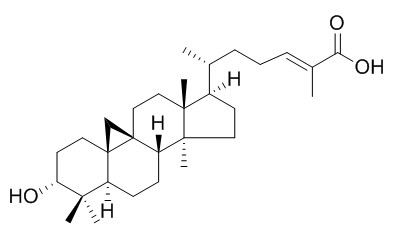Isomangiferolic acid
Reference standards.
Inquire / Order:
manager@chemfaces.com
Technical Inquiries:
service@chemfaces.com
Tel:
+86-27-84237783
Fax:
+86-27-84254680
Address:
1 Building, No. 83, CheCheng Rd., Wuhan Economic and Technological Development Zone, Wuhan, Hubei 430056, PRC
Providing storage is as stated on the product vial and the vial is kept tightly sealed, the product can be stored for up to
24 months(2-8C).
Wherever possible, you should prepare and use solutions on the same day. However, if you need to make up stock solutions in advance, we recommend that you store the solution as aliquots in tightly sealed vials at -20C. Generally, these will be useable for up to two weeks. Before use, and prior to opening the vial we recommend that you allow your product to equilibrate to room temperature for at least 1 hour.
Need more advice on solubility, usage and handling? Please email to: service@chemfaces.com
The packaging of the product may have turned upside down during transportation, resulting in the natural compounds adhering to the neck or cap of the vial. take the vial out of its packaging and gently shake to let the compounds fall to the bottom of the vial. for liquid products, centrifuge at 200-500 RPM to gather the liquid at the bottom of the vial. try to avoid loss or contamination during handling.
Int J Mol Sci.2019, 21(1):E265
ScienceAsia2024, 50,2024073:1-9
Biomedicines.2020, 8(11):486.
J Food Sci.2024, 3841.17112.
Korean j.of Pharm.2017, 70-76
Cell Mol Biol(Noisy-le-grand)2019, 65(7):77-83
J Ethnopharmacol.2020, 249:112381
An Acad Bras Cienc.2023, 95(3):e20220672
Sci Rep.2021, 11(1):14180.
Korean J. Medicinal Crop Sci2021, 10:345-352.
Related and Featured Products
Phytochemistry. 2014 Oct;106:156-63.
Characterisation of triterpenes and new phenolic lipids in Cameroonian propolis.[Pubmed:
25104230]
METHODS AND RESULTS:
Chemical investigation of a sample of propolis originating from North-Western Cameroon led to the isolation of thirteen alk(en)ylphenols (1-13) (inseparable mixture) along with α-amyrin (14), β-amyrin (15), lupeol (16), cycloartenol (17), mangiferonic acid (18), ambonic acid (19), mangiferolic acid (20), ambolic acid (21), Isomangiferolic acid (22) and nine alk(en)ylresorcinols (23-31) (inseparable mixture). All compounds were identified following analysis of their spectroscopic data and comparison with previously published reports. Compounds (8), (12), (13) and (30) are new natural products. GC-MS analysis carried out on the alk(en)ylphenol and alk(en)ylresorcinol mixtures (dimethyl disulphide trimethylsilyl derivatives) revealed the presence of saturated and mono-unsaturated compounds with side chain lengths ranging from C11 to C19 and C15 to C19, respectively. The position of the double bond in mono-unsaturated derivatives was established from the characteristic fragments resulting from the cleavage of the bond between the two methylthio-substituted carbons. The most abundant compound in each mixture was 3-(12'Z-heptadecenyl)-phenol (10) and 5-(12'Z-heptadecenyl)-resorcinol (29).
CONCLUSIONS:
This study is the first to report the presence of triterpenes (except for lupeol) and phenolic lipids, including eighteen compounds previously unreported in bee glue, in an African sample.



